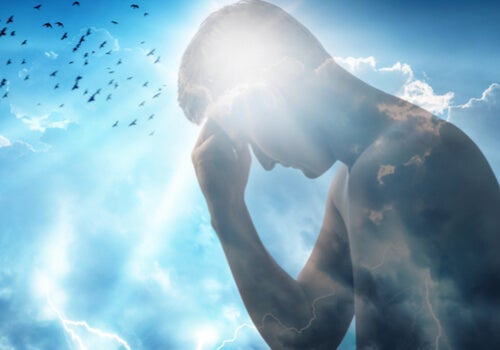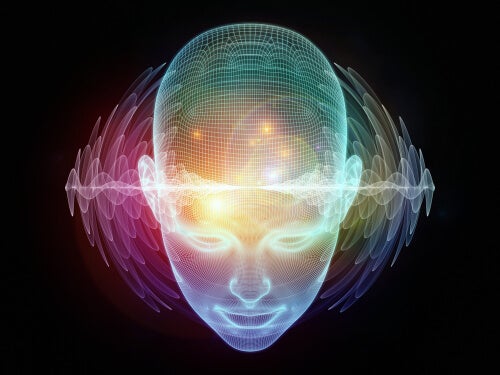The Levels of Consciousness and Their Colors

Ken Wilber is an American author who’s focused his work and studies on philosophy, mysticism, ecology, and spiritual evolution. His years of work in these areas gave rise to what he calls the integral theory of consciousness. This is a theory that states that human beings have different levels of consciousness and that each one has its own color.
The basic idea in Wilber’s terminology would be that human beings aren’t differentiated by their race or skin color, but rather by their state of consciousness. According to his theories, consciousness isn’t static. On the contrary, he says that it’s a spiral dynamic that experiences continuous change, depending on a person’s experiences.
Wilber’s integrative model is a spiral that differentiates two blocks: first tier thought or subsistence levels and second tier thought or levels of being and integral consciousness.
He states that there are six levels of subsistence in consciousness and two additional ones in the consciousness of our being. In addition to this, each one has its own color and particular characteristics. Thus, we’re going to carry out a review of Wilber’s first six subsistence levels.
Wilbur’s levels of consciousness

The color beige: archaic-institutional state
This is the basic state of survival, dominated by biological impulsiveness. It’s a state where the senses reign and the person is defined by the basic needs they need to cover.
The existence of these people is based on automatism and their thoughts are guided by instinct. This occurred in the first human societies, and also occurs these days in newborn babies and old people suffering from some kind of degenerative disorder.
The color purple: magical-animistic state
At this level, there’s a type of magical world that fills the individual with security and harmony. The person can distinguish between good and evil. In addition to that, it’s a state of security in which people find protection from threatening surroundings.
Rituals, kinship ties, and magic fight the powers and spirits and beliefs and superstitions are also important. This is the level of consciousness of many ethnic tribes.
The color red: power gods
This state of consciousness is the person who thinks that life is a jungle where only the strong succeed. On this level, the weak are at the service of the strong. Conquest, power, and submission are seen as positive.
This part of the spiral emerges from the previous one and does so through an ego that sets them apart from the group. This is a powerful, impulsive, self-centered, and heroic personality. In this red color state, a person still believes in magic but the mystical powers are associated with the leaders.
The color blue: mystical order
This is a state in which order and stability reign. A higher authority would control things in this state and would reward good works and punish evil.
Submission and acceptance of rules are also quite normal and people accept them willingly. The explanation regarding this world comes from the hand of an all-powerful entity that controls everything. This is a characteristic state in Confucian China and in orders of chivalry.
The color orange: scientific achievement
This type of person has a pragmatic state of mind that requires them to achieve results and progress in life. They don’t follow other people and decide to seek the truth on their own. In this state, the world is a perfectly adjusted machine that works on the basis of behavioral laws. This would be the state of consciousness of the emerging middle class, materialism, and discovery and success.
The color green: the sensitive person
In this new state, humanity lives together in society and has common purposes. They seek consensus and social awareness and base their lives around community and the relationship between all human beings.
Dogma, greed, and division have been extinguished. It’s a state based on harmony and the potential of human development. There are no longer any hierarchies, and the focus is on spiritual matters. We can find this state in post-modernism.

The levels of being and integral consciousness
As we seek to develop Wilbur’s thoughts, it’s possible to update the state of the sensitive ego, the green one, even more. Here we can make the jump to “second tier thinking”. As a result, on the subsistence levels, we can see the characteristic of being independent of each other and not integrated.
The states of this “second tier thinking” are integrated and not exclusive. These two levels are related to integral consciousness and the first is yellow, and the second, turquoise, the last one in the spiral.
- The color yellow color – integrative state. In this state, the integration of processes occurs. Thus, chaos, change, and uncertainty are acceptable states. Life revolves around flexibility, spontaneity, and functionality. Egalitarianism is possible by the acceptance and understanding of the degrees of the commands.
- The color turquoise color – holistic state. This is the state of thought that uses all the previous levels of the spiral to achieve unity. It’s a holistic state that also keeps the interwoven forces in balance.
Integral theory and levels of consciousness
Wilber’s integral theory seeks to find a broader understanding of the human being. Therefore, it refers to an awareness that integrates different perspectives. It would be something like a map of perspectives that organizes beliefs and values.
Ken Wilber, through this integrative model, believes that it would be possible to avoid the catastrophic cultural disaster that the materialistic worldview is bringing about by ignoring human potential and achievements.
Ken Wilber is an American author who’s focused his work and studies on philosophy, mysticism, ecology, and spiritual evolution. His years of work in these areas gave rise to what he calls the integral theory of consciousness. This is a theory that states that human beings have different levels of consciousness and that each one has its own color.
The basic idea in Wilber’s terminology would be that human beings aren’t differentiated by their race or skin color, but rather by their state of consciousness. According to his theories, consciousness isn’t static. On the contrary, he says that it’s a spiral dynamic that experiences continuous change, depending on a person’s experiences.
Wilber’s integrative model is a spiral that differentiates two blocks: first tier thought or subsistence levels and second tier thought or levels of being and integral consciousness.
He states that there are six levels of subsistence in consciousness and two additional ones in the consciousness of our being. In addition to this, each one has its own color and particular characteristics. Thus, we’re going to carry out a review of Wilber’s first six subsistence levels.
Wilbur’s levels of consciousness

The color beige: archaic-institutional state
This is the basic state of survival, dominated by biological impulsiveness. It’s a state where the senses reign and the person is defined by the basic needs they need to cover.
The existence of these people is based on automatism and their thoughts are guided by instinct. This occurred in the first human societies, and also occurs these days in newborn babies and old people suffering from some kind of degenerative disorder.
The color purple: magical-animistic state
At this level, there’s a type of magical world that fills the individual with security and harmony. The person can distinguish between good and evil. In addition to that, it’s a state of security in which people find protection from threatening surroundings.
Rituals, kinship ties, and magic fight the powers and spirits and beliefs and superstitions are also important. This is the level of consciousness of many ethnic tribes.
The color red: power gods
This state of consciousness is the person who thinks that life is a jungle where only the strong succeed. On this level, the weak are at the service of the strong. Conquest, power, and submission are seen as positive.
This part of the spiral emerges from the previous one and does so through an ego that sets them apart from the group. This is a powerful, impulsive, self-centered, and heroic personality. In this red color state, a person still believes in magic but the mystical powers are associated with the leaders.
The color blue: mystical order
This is a state in which order and stability reign. A higher authority would control things in this state and would reward good works and punish evil.
Submission and acceptance of rules are also quite normal and people accept them willingly. The explanation regarding this world comes from the hand of an all-powerful entity that controls everything. This is a characteristic state in Confucian China and in orders of chivalry.
The color orange: scientific achievement
This type of person has a pragmatic state of mind that requires them to achieve results and progress in life. They don’t follow other people and decide to seek the truth on their own. In this state, the world is a perfectly adjusted machine that works on the basis of behavioral laws. This would be the state of consciousness of the emerging middle class, materialism, and discovery and success.
The color green: the sensitive person
In this new state, humanity lives together in society and has common purposes. They seek consensus and social awareness and base their lives around community and the relationship between all human beings.
Dogma, greed, and division have been extinguished. It’s a state based on harmony and the potential of human development. There are no longer any hierarchies, and the focus is on spiritual matters. We can find this state in post-modernism.

The levels of being and integral consciousness
As we seek to develop Wilbur’s thoughts, it’s possible to update the state of the sensitive ego, the green one, even more. Here we can make the jump to “second tier thinking”. As a result, on the subsistence levels, we can see the characteristic of being independent of each other and not integrated.
The states of this “second tier thinking” are integrated and not exclusive. These two levels are related to integral consciousness and the first is yellow, and the second, turquoise, the last one in the spiral.
- The color yellow color – integrative state. In this state, the integration of processes occurs. Thus, chaos, change, and uncertainty are acceptable states. Life revolves around flexibility, spontaneity, and functionality. Egalitarianism is possible by the acceptance and understanding of the degrees of the commands.
- The color turquoise color – holistic state. This is the state of thought that uses all the previous levels of the spiral to achieve unity. It’s a holistic state that also keeps the interwoven forces in balance.
Integral theory and levels of consciousness
Wilber’s integral theory seeks to find a broader understanding of the human being. Therefore, it refers to an awareness that integrates different perspectives. It would be something like a map of perspectives that organizes beliefs and values.
Ken Wilber, through this integrative model, believes that it would be possible to avoid the catastrophic cultural disaster that the materialistic worldview is bringing about by ignoring human potential and achievements.
All cited sources were thoroughly reviewed by our team to ensure their quality, reliability, currency, and validity. The bibliography of this article was considered reliable and of academic or scientific accuracy.
- Donkers, Harry (2016) Integral Dynamics, A new integration of Wilber’s Integral Theory and Spiral Dynamics. International Journal of Humanities and Social Science Vol. 6, No. 6
- Landrum, Nancy E. (2005) Using integral theory to effect strategic change. Journal of Organizational Change Management 18(3):247-258
This text is provided for informational purposes only and does not replace consultation with a professional. If in doubt, consult your specialist.







